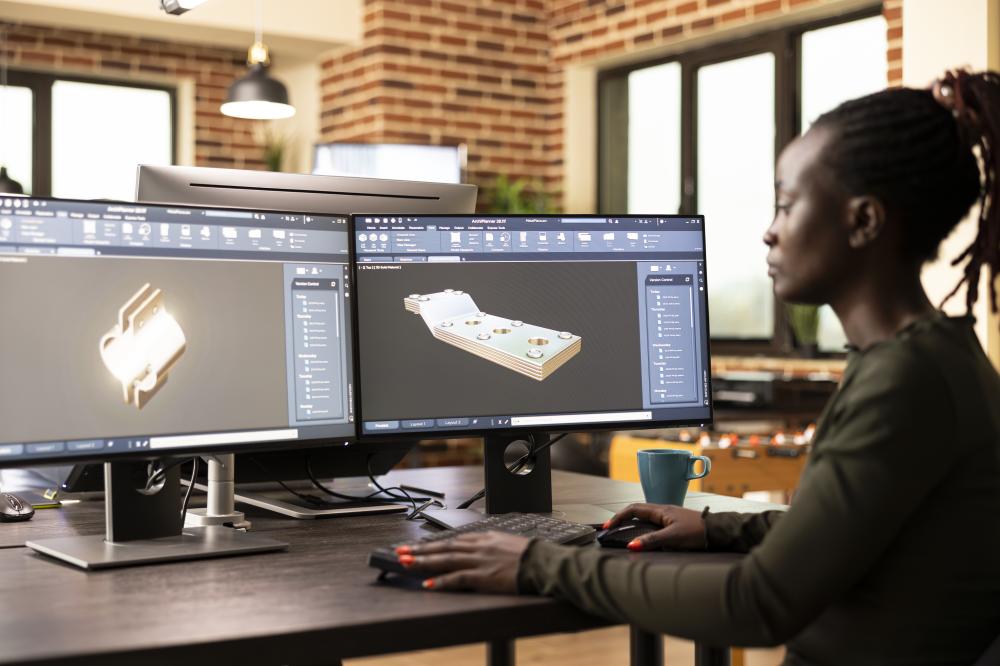Solidworks Hardware Requirements Wisconsin

Key Elements of Solidworks Hardware Needs
For those navigating the Solidworks Hardware Requirements Wisconsin, it’s crucial to know what makes a system thrive. The processor, often called the brain of your setup, plays a pivotal role. High-performance CPUs, particularly Intel’s i7, i9, or Xeon, are staples in this arena. These choices are not arbitrary; they’re grounded in my extensive experience advising on optimal setups.
Memory is the next pillar. While 8GB might suffice for basic tasks, 32GB ensures smoother operation, especially for larger projects. GSC clients who handle complex assemblies often find that 64GB or more is essential. The shift to solid-state drives (SSDs), particularly NVMe SSDs, revolutionizes file access and reduces downtime significantly.
A graphics card is not merely an accessory for Solidworks; it’s essential. NVIDIA’s Quadro series shines with its compatibility and reliability. When clients invest in these, they often remark on the drastic improvements in rendering and overall performance.
The Impact on Wisconsin Professionals
Working with Solidworks in Wisconsin presents unique challenges. The local industry thrives on innovation, from manufacturing to academia. Every field places distinct demands on hardware, necessitating nuanced solutions. For instance, my clients in Madison’s research labs need systems that handle intensive simulations with ease.
Manufacturers across Milwaukee require robust setups to keep pace with detailed design work. Their success hinges on systems that not only meet but exceed the minimum standards. This leap often translates into faster project completion and enhanced productivity.
Wisconsin’s diverse landscape means businesses must be as resilient as the hardware they employ. A client once shifted from HDDs to SSDs, and the improvement in project turnaround times was palpable. It’s transformations like these that reaffirm the importance of strategic hardware investments.
The conversations I have with clients often circle back to how exceeding the Solidworks Hardware Requirements Wisconsin allows them to push boundaries. They don’t just meet deadlines; they redefine them, driving innovation across the state.
What Are Common Questions About Solidworks Requirements?
One frequent inquiry is what distinguishes a basic setup from an exceptional one. Simply put, a high-quality processor, ample RAM, and a reliable SSD setup form the core.
Another question involves the role of the graphics card. It’s not just about improving visuals; it’s about enhancing functionality. For tasks utilizing RealView or Ambient Occlusion, a potent GPU like the Quadro series is invaluable.
Clients often ask, “How much RAM is necessary?” While 16GB suffices for moderate use, stepping up to 32GB minimizes bottlenecks, especially as project complexity grows. In some cases, advancing to 64GB or even 128GB ensures future-proofing.
Steps to Choose the Right Hardware for Solidworks
When selecting the best hardware for Solidworks, it’s crucial to take decisive steps:
- Select a processor known for high performance, such as the Intel i7, i9, or Xeon.
- Invest in at least 32GB of RAM to handle more complex projects smoothly.
- Opt for an NVMe SSD, which significantly enhances speed and efficiency in file management.
- Choose an NVIDIA Quadro or AMD Radeon Pro graphics card to ensure optimal rendering and stability.
These steps ensure that the hardware not only meets but exceeds the Solidworks Hardware Requirements Wisconsin, setting you up for long-term success.
GSC’s Approach to Personalized Solutions
At GSC, we understand that every professional’s needs vary. Our personalized approach means we dive deep into understanding each client’s specific requirements. This ensures we tailor hardware solutions that maximize efficiency.
During consultations, we consider both the technical and aspirational aspects of our client’s goals. It’s this dual focus that enables us to offer advice that aligns with their long-term vision. For instance, suggesting scalable storage solutions to firms with expansion in mind.
Our clients have repeatedly commended our ability to anticipate challenges and offer solutions that future-proof their investments. This proactive approach is what turns routine consultations into strategic partnerships.
It’s not just about finding the right fit today; it’s about ensuring that hardware investments continue to deliver value, meeting and exceeding the Solidworks Hardware Requirements Wisconsin well into the future.

Understanding SolidWorks Hardware Needs in Wisconsin
What are the essential hardware components for running SolidWorks effectively in a Wisconsin-based professional setting?
In my experience, particularly with professionals in Wisconsin, three pivotal components come into play: a high-performance CPU, ample RAM, and a robust graphics card. For instance, processors like Intel’s i7 or i9 offer the power needed for complex simulations and designs, which are common in Wisconsin’s manufacturing and research sectors. RAM is another critical element. While 16GB is a baseline, professionals handling complex projects benefit significantly from 32GB or even 64GB. Lastly, a reliable graphics card, such as NVIDIA’s Quadro series, can make a substantial difference. It’s not just about visuals; it ensures efficiency and stability in rendering, which is crucial for meeting tight deadlines and pushing innovation.
How does the choice of hardware impact professionals using SolidWorks in Wisconsin?
The right hardware setup can be transformative for Wisconsin professionals, enabling them to maintain a competitive edge. Take a manufacturing firm in Milwaukee, for example. By upgrading from traditional HDDs to SSDs, they reported a noticeable improvement in project turnaround times, which directly translated into increased productivity and the ability to take on more projects. In Madison’s research labs, robust setups capable of handling intensive simulations mean that professionals can focus more on innovation rather than waiting for processes to complete. This kind of strategic hardware investment doesn’t just meet current needs; it sets the stage for future growth and advancements in the industry.
What steps should be taken to choose the right hardware for SolidWorks?
Choosing the right hardware involves a few strategic steps. First, decide on a processor known for reliability and speed, such as Intel’s i7, i9, or Xeon models. These are like the brain of your system, and you want a strong one. Next, ensure your system has at least 32GB of RAM to efficiently handle more complex tasks. It’s always better to overestimate your needs slightly than to find yourself constrained later. You’ll also want to invest in an NVMe SSD for faster file access and reduced downtime. Choose a dependable graphics card like the NVIDIA Quadro or AMD Radeon Pro for optimal rendering capabilities. These choices ensure your hardware not only meets but exceeds SolidWorks requirements, providing a solid foundation for success.
What are some common misconceptions about SolidWorks hardware requirements?
One common misconception is that SolidWorks can run seamlessly on any modern computer. While that’s partially true for very basic use, to truly harness the power of SolidWorks, especially for complex tasks, specific hardware is necessary. Another misunderstanding is the importance of the graphics card. Some believe it’s only about improving visuals, but in reality, the graphics card enhances the overall functionality and performance for tasks that involve RealView or Ambient Occlusion. Additionally, many assume that more RAM means better performance universally. While that’s often true, it’s essential to balance RAM with the right CPU and SSD to prevent bottlenecks. Understanding these nuances can save users a lot of frustration and downtime.
How does GSC’s approach to personalized solutions enhance SolidWorks performance?
At GSC, we go beyond just recommending hardware; we tailor solutions to meet specific client needs. For example, during consultations, we consider not only the technical aspects but also the aspirational goals of our clients. This dual focus allows us to provide solutions that align with both immediate and long-term objectives. For instance, if a company plans to expand, we might suggest scalable storage solutions that accommodate growth without requiring a complete system overhaul. This proactive approach turns a routine consultation into a strategic partnership, ensuring that our clients’ investments continue to deliver value and keep pace with evolving industry standards.
What considerations are important for future-proofing a SolidWorks setup?
Future-proofing your SolidWorks setup involves anticipating changes and ensuring your hardware can adapt. One strategy is to choose a motherboard that supports higher RAM capacities than you initially need. This way, as your projects grow in complexity, you can easily upgrade your system. Opt for components that are not just current but have shown a track record of longevity and reliability. Incorporating cloud solutions like those offered by platforms such as 3DEXPERIENCE can also add flexibility and adaptability to your tech stack. Engaging with expert consultations, like those provided by GSC, can also help you identify potential shifts in tech trends and prepare accordingly, ensuring your setup remains robust and effective.
